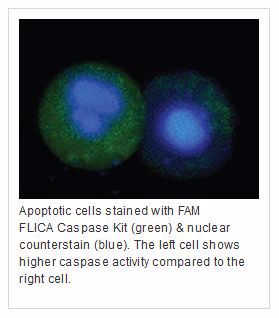Apoptosis, a form of programed cell death, is directed by activated caspases. Caspases are cysteine proteases that can cleave other proteins, and upon activation, create a positive-feedback cascade, which ensures the cell will undergo apoptosis.
Our FLICA Caspase Apoptosis Detection Kits allow analysis of active caspases in whole, living cells. Their methodology is based on a unique cell-permeable and non-cytotoxic reagent called the Fluorochrome Inhibitor of Caspases (FLICA). The reagent contains a caspase inhibitor sequence (such as VAD) linked to a green (carboxyfluorescein, FAM) or red (sulforhodamine, SR) fluorescent probe.
FLICA passes through an intact plasma membrane and covalently binds to the active caspase. Any unbound FLICA diffuses out of the cell and is washed away. As FLICA only binds to the active caspase, there is no interference from pro-caspases or inactive forms of the enzyme. The remaining fluorescent signal gives a direct measure of the amount of active caspase in the whole living cell. Cellular analysis may be performed with a fluorescence microscope, plate reader or flow cytometer.
Results (see Figure) using FLICA Poly Caspase Kits (Product Code ICT091& ICT092) analyzed by fluorescence microscopy show suspension cells labeled with FAM-VAD-FMK, and Hoechst 33342 stain. Both cells are apoptotic and dying - detected by (green) caspase activity and (blue) nuclear Hoechst staining. The left cell is much brighter green than the right cell, indicating that the left cell has more active caspases.

